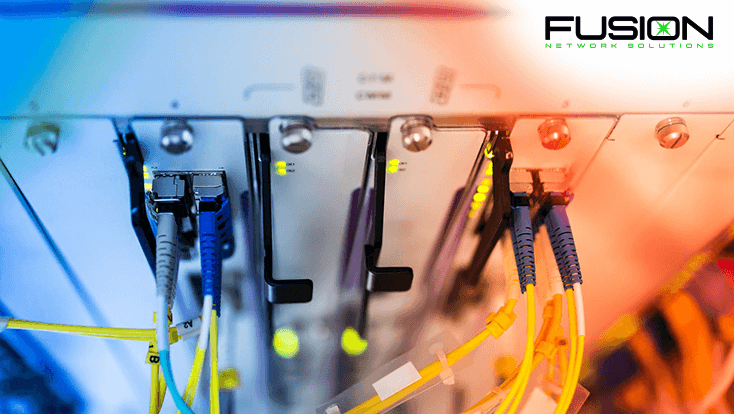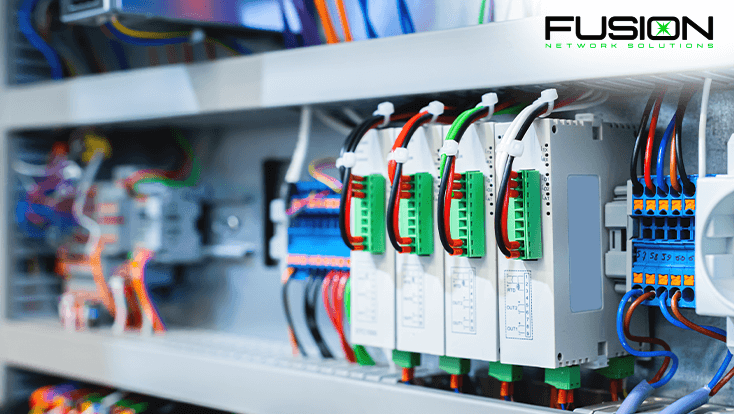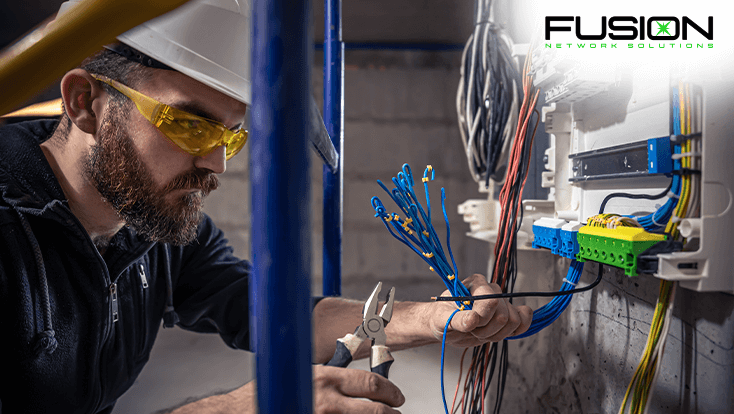In the modern hyper-connected world, companies and homes require quicker, more dependable internet. This is why fibre optic cable installation has become the pillar of modern infrastructure. Unlike copper wires, fibre optics carry data in the form of light, providing unmatched speed and capacity.
At Fusion Network Solution, we have expertise in high-quality fibre optic cabling services for industrial and commercial markets. Upgrade your network or install a new one, you need to know the basics of fibre optics.
Here, we’re going to take you through the whole process of fibre optic cable installation, from types of fibre optic cabling to methods of installation, tricks of the trade, and how services such as pallet rack installation services are also involved in data center and warehouse installations.
What Is Fibre Optic Cabling?
Fibre optic cables utilize thin glass or plastic fibre strands to transmit data in the form of pulses of light. It can transmit data faster over longer distances with less signal loss than metal cables.
Two main forms of fibre optic cables exist:
Single mode optical fiber
- Most suitable for distance communication
- Applied in telecom and backbone network infrastructure
- Uses one path of light
- Provides greater bandwidth with less signal loss
- Generally more costly
Multi mode optical fiber
- Better suited for shorter ranges (such as in buildings or data centers)
- Employ the use of multiple light paths
- Simpler to install and manage
- Less expensive for LAN applications
Why Fibre Optic Cable Installation is a Worthy Investment
- Future-Proofing: Fibre provides much more bandwidth and is scalable for future needs.
- High Speeds: Compatible with speeds of up to 100 Gbps and more.
- Increased Reliability: Not susceptible to electromagnetic interference and is less likely to be damaged.
Less maintenance and less replacement mean cost savings over time.
Real-Life Example: Multi mode fiber from a logistics firm in Toronto upgraded warehouse network. This resulted in 60% downtime reduction within the network. It paid for itself within eight months.

The Fibre Optic Cable Installation Process
At Fusion Network Solution, our process of installation in fibre optics, is performed in strict adherence to the best practice of the industry for high efficiency and safety.
1. Site Survey and Planning
Before any cable is pulled, we assess the site layout and determine the best routing paths. This includes:
- Distance calculation
- Environment evaluation (indoor vs. outdoor)
- Infrastructure compatibility
Tip: Always account for future expansion during planning. Installing conduits or spare fiber now can save significant costs later.
2. Selecting the Right Cable Type
Choosing between single mode optical fiber and multi mode optical fiber depends on your specific needs:
Single Mode Optical Fiber
- Best used in long-distance telecom, campus networks, and between-building connections
- Effective for carrying over 40 km or more distances
- Typically more expensive because of its specialized status
Multi Mode Optical Fiber
- Best suited for office complexes, campuses, and data centers
- Suitable for up to 550 meters of distance
- Cost-effective for use in the short range
Fusion Network Solution tends to suggest multi mode optical fiber for corporate LANs and single mode optical fiber for long-distance communication between buildings or campuses.
3. Cable Routing and Infrastructure Installation
This phase involves physically routing cables via conduits, ducts, wall penetration, ceiling penetration, or underground trenches. In industrial or warehouse settings, this is frequently coupled with pallet rack installation services.
Cable management with pallet rack installation services ensures:
- Physical protection of the fibre optic cabling
- Airflow and maintenance accessibility
- Safety compliance
Example: A large e-commerce fulfillment centre in Montreal used pallet rack applications that integrated cable trays vertically to improve their layout of networks, reducing maintenance time by 40%.
4. Termination and Testing
Terminating the fiber-optic cables
Once the routing has been accomplished, the fiber-optic cable’s termination is completed using LC, SC, or ST connectors, depending on the equipment. This makes some require splicing or polishing in order to minimize signal loss.
After termination, we run the following tests:
- OTDR (Optical Time Domain Reflectometer) testing to identify signal loss or breaks
- Light source and power meter testing to validate performance metrics
5. Documentation and Maintenance
Correct documentation consists of:
- Route maps
- Test results
- Maintenance schedules
This keeps your fibre optic cabling in check, particularly during troubleshooting or expansion.

Tips for a Successful Fibre Optic Cable Installation
Plan for Growth
Utilize high-capacity cables or reserve fibres (dark fibre) for future use.
Prevent Sharp Bends
Flexing cable too much will result in signal loss. Keep minimum bend radius.
Use Quality Materials
Purchase good-quality connectors and protective conduits.
Integrate with Infrastructure
Bundle your pallet rack installation services with network installation to save on installation time and mess.
Hire Professionals
DIY can be cheap in the short run but end up being expensive in downtime. Let certified installers such as Fusion Network Solution do the work for you.
Common Challenges and How to Overcome Them
- Signal Loss: Due to bad splicing or too many bends. Solution: Test extensively and use bend radius recommendations.
- Incorrect Labeling: Causes misidentification during fault finding. Solution: Label each strand and path clearly.
- Environmental Hazards: Cables outside are exposed to weather, rodents, and digging damage. Solution: Utilize armored or direct-burial rated cables and protective conduits.
Fibre Optic Cabling vs. Wireless Solutions
You may ask: “Why not wireless?” Here’s why fibre optic cabling remains the gold standard:
Fibre Optic Cabling
- Up to 100 Gbps or more speed
- Very low latency
- Highly reliable – resistant to interference
- Very secure and difficult to tap
Wireless Solutions
- Maximum theoretical speeds up to 10 Gbps
- Greater latency, particularly with walls or obstructions
- More susceptible to signal loss and interference
- Easy to intercept without security
In mission-critical sectors such as hospitals, financial institutions, and industrial plants, fibre optic cable installation has no competitor.
How Fusion Network Solution Can Assist
With years of experience in fibre optic cabling, pallet rack installation services, and IT infrastructure development, we at Fusion Network Solution are equipped to assist you. Our certified installers guarantee accurate installations, whether a few strands or a campus-wide rollout.
From consultation to implementation, we offer:
- Free site assessments
- Scalable network plans
- High-quality materials and equipment
- Support for both single mode optical fiber and multi mode optical fiber
Conclusion
Whether you’re a business looking to upgrade your network or a facility manager planning a new installation, understanding the essentials of fibre optic cable installation is crucial. With the right cable type, professional installation, and a clear roadmap, fibre optics can revolutionize your connectivity.
Fusion Network Solution is your reliable partner for safe, scalable, and efficient fibre optic cabling and infrastructure solutions.
